From Spiez onwards, the Camino de Santiago is no longer marked as such, as it officially runs via Thun. To walk on the "old" St. James' Way, follow the yellow hiking signs. The Way of St. James begins in front of the castle and leads up the castle road to the first crossroads with hiking trail signs. There you follow the signs to Einigen (Hans Barben Weg), then to Strättligsteg - on this we cross the Kander. Then follow the signs to Gwattegg (via the Burgunderweg) and there you will find yourself back on route 4, the Via Jakobi (St. James Way).
From the castle we walk past the ice-aged "Katzenstein", through beautiful vineyards and enjoy the view.
Above the vineyards, the path leads over the Spiezberg and then into the Spiezmoos. At the edge of the Egliwald we walk westwards. After the forest, at a farmstead (signpost Kumm-Einigen), we have to decide whether we want to go down to the right via the church Einigen, or continue straight ahead for a shorter distance directly to Strättligsteg. The path over Einigen takes us across meadows down to the railway subway and on to the busy Thunerstrasse. Follow the road to the left on the pavement and after about 400 metres turn right into the village of Einigen. From here it is about 500 metres to the church.
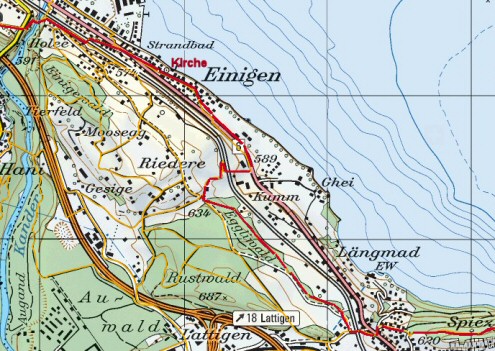
If you want to visit the church in Einigen, you need a detailed map to turn right at a crossroads after Eggliwald (before Riedere).
Built between the 10th and 11th centuries, it is the oldest of the twelve so-called "1000 year old churches on Lake Thun". The church of Einigen was planned by Arnold von Strättligen and built by King Rudolf II of Burgundy. It is dedicated to the archangel Michael.
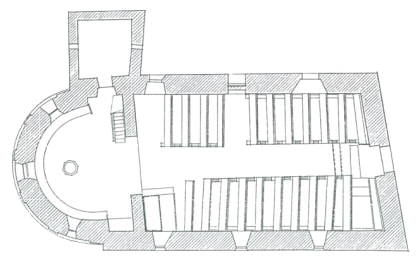
Ground plan of the church of Einigen. Who thinks it stands a little diagonal in the landscape is wrong. All 12 Lake Thun churches are geometrically connected to each other by their axial alignment.
The simple interior of the Romanesque church. In the apse there is a baptismal font from 1446 with the Bubenberg coat of arms. On the right is the baroque pulpit.
The church is very popular for weddings. So we congratulate Reto and Jasmin, who got married here at the end of May 2012 and chose this picture for their wedding homepage.
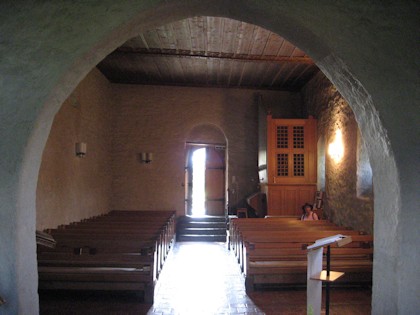
View from the small choir towards the entrance. In the background a pilgrim is sitting.
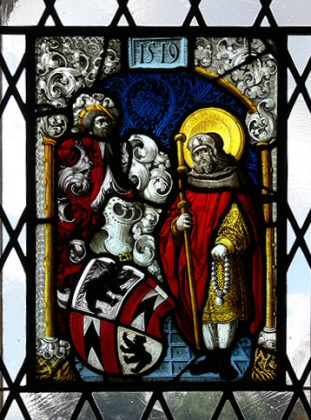
In one of the windows you can see a coat of arms of Ludwig von Erlach and Barbara Schmid von Uri with the date 1519. St. James with his typical headdress with a shell holds a pilgrim's staff in his right hand and a rosary in his left hand.
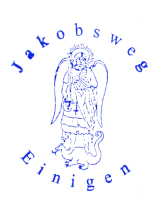
After Einigen the path leads through the wild and romantic Kanderschlucht (gorge).
Here we cross the Kander at Strättligsteg (Steg = footbridge).
The Kander from the bridge. Unfortunately, as we now know after the tragic accident, it is not suitable for river rafting.
Via a footbridge we reach the Strättlighügel (hill), the mighty moraine of the former Aare glacier. The "Burgunderweg" (Burgundy Trail) runs along it. In the nearby woods are the Strättlig ruins, the former ancestral castle of the Burgundian king Rudolf. He was the legendary builder of the famous 12 Lake Thun churches and had a major influence on this region in the Middle Ages.
At the end of the moraine we come to Gwattegg.

from Thun
In Gwattegg, the pilgrims' route variants via Thun and via Spiez meet
together again, and the ascent to Amsoldingen begins.
The Romanesque church of Amsoldingen was built around 933 as a three-nave basilica and is unique in the Lake Thun region. Before that, a Roman sanctuary existed nearby.
The nave with the raised choir, similar to the Spiez castle chapel.
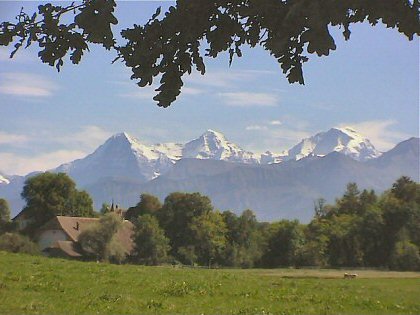
View near Amsoldingen. Unfortunately, this view was denied to us. The photo shows how it could have been.
The path leads past the Uebeschi lake.
The new route leads up to the left, through Uebeschi and on via Honegg, through a former moraine landscape into the Gürbetal valley to Blumenstein.
Has a photo from a safari got lost here, misplaced?
Indeed, we met a zebra on the Way of St. James. After the village of Uebeschi a farmer keeps zebras.
The photo stimulates the discussion: Is a zebra striped lengthwise or crosswise?
House in Blumenstein with the inscription
1741
Erbauen durch Hans Kufener
und seine Söhne Hans Bernhart und Benedicht Kufener.
Herr lass uns sammlen hier, Gib aber auch den Segen
Dann alles Ist an Dier Und Deiner Gnad gelegen
1741
Built by Hans Kufener
and his sons Hans Bernhart and Benedicht Kufener
Lord let us gather here, but also give the blessing
Because all depends on you and your grace
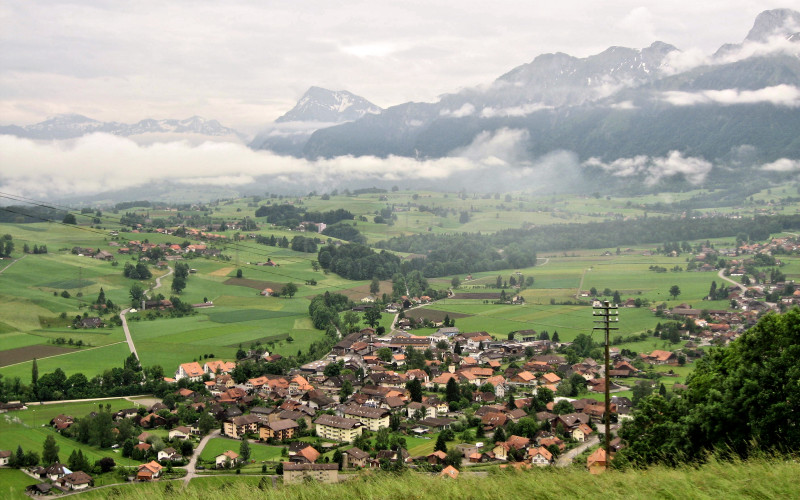
The stage goal Wattenwil has been reached.
(This view of Wattenwil can only be seen if you continue from Wattenwil towards Burgistein.)
At Gasthof Bären in the middle of Wattenwil, our little hiking group occupied all 4 rooms
